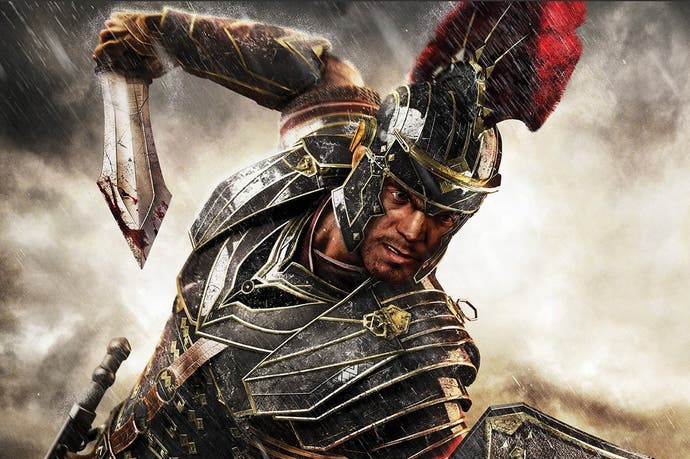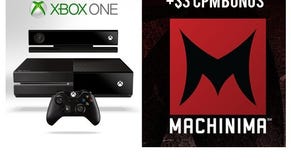Digital Foundry: Hands-on with Ryse on PC
The state of the visual arts.
It's been 10 months since the release of Ryse on Xbox One - one of the most fascinating games of the next-gen launch period. Crytek's hack-and-slash title stood proud as one of the most technologically advanced - and utterly beautiful - games of that wonderful, chaotic period. While the technological prowess of the Microsoft console came under repeated fire at launch, Ryse demonstrated that Xbox One was a contender - that it could compete. There was just one problem - for all its technical sophistication, the extremely repetitive gameplay was a severe disappointment.
Let's make one thing perfectly clear - anyone expecting the upcoming PC version to address any of the fundamental issues present in the original game is going to be very disappointed. It is, to all intents and purposes, the exact same game, with all the Xbox One DLC bundled. But everyone looking forward to the PC release probably knows this, and most likely doesn't care - the chances are that they want to see their gaming hardware of choice pushed to its limits, experiencing Crytek's phenomenal technology unshackled from the restrictions of the Microsoft console.
To put things into perspective, we returned to the original Xbox One release to better understand the limitations Crytek was operating under. What we found were two key areas ripe for improvement. First up, there's the controversial issue of resolution - Ryse operates with an internal 1600x900 framebuffer, upscaled using a custom filter to full 1080p. Of more concern to us is the uneven frame-rate: to all intents and purposes, it is a 30fps title (read our Cevat Yerli interview for the decision-making process there) but the pace of the arrival of new frames is uneven, with noticeable judder, albeit mitigated to a certain extent by one of the best motion blur implementations we've seen in gaming.
The PC version we tested - a two-level press demo - offers the opportunity to resolve these issues conclusively. Slotting a Radeon R9 290 into our Core i7 3770K PC overclocked to 4.3GHz, Ryse's spectacular opening renders beautifully at a native 1080p, with a flawless 60fps update. A 30fps cap is included in the options, but crucially, Crytek allows PC users to run fully unlocked - and given the right hardware, the impact is spectacular. However, what is interesting is that the developer allows users to access many of the technologies used on Xbox One - the internal scaler is there (allowing those with less powerful rigs to upscale to 1080p with a native resolution HUD), along with Crytek's innovative temporal anti-aliasing - a crucial element of the game's visual make-up.
What's clear from our testing - and showcased quite spectacularly in the comparison video above - is that the ability to shape the performance level of the game has far more of a positive impact on the title than running it at native 1080p. Slowed down to 25 per cent speed, the ebb and flow of the Xbox One update is very much at odds with the sheer consistency of the PC's delivery of new frames. But image quality? There's an improved clarity to the game in motion, and a hint of blur on Xbox One (especially evident in completely static scenes), but it's hardly a revelatory improvement, with the advantage mostly lost in movement. We need to move to 2560x1440 and 4K to see a truly game-changing difference - and that requires some serious GPU power.
The explanation behind the diminishing returns at 1080p comes down to the brilliance of Crytek's technologies and the forward-looking artistic choices made by its visual production team. On a base level, what truly impresses with Ryse is how unlike a traditional 3D video game it looks - hard, geometric edges are hard to discern in the overall presentation (and stick out like a sore thumb when they do), while the traditional lower-poly squared-off curves are seemingly entirely absent. Materials are lit masterfully with what we would rank as the most natural, consistent examples of physically based lighting we've seen in the current-next-gen gaming era.
We might not entirely agree with Cevat Yerli's thoughts on 30fps as an effective cinematic standard for gaming (particularly in terms of an audience aversion to higher frame-rate presentations) but the whole rendering pipeline seen in this latest iteration of CryEngine is very much aiming for a filmic look. Putting the York forest stage alongside Crysis 3's jungles reveals an enormous jump in overall visual quality - a true leap forward in lighting, detail and anti-aliasing. It looks marginally better rendered at native 1080p, but locking down that 30fps makes more impact to the fidelity of the presentation, while moving up to full-fat 60fps propels Ryse onto the next level.
Alternative options:
- Campaign level one gameplay (YouTube, play at 2x speed)
- Campaign level four gameplay (Eurogamer player, standard def)
- Campaign level four gameplay (YouTube, play at 2x speed)
The next question on our minds concerned the raw assets and rendering options available to PC owners, and how they compared with the Xbox One game. Could we see a new layer of art quality and rendering options that would elevate the PC game over the original console presentation? Well, to begin with, we do need to stress that all we have to work with right now is a two-level demo, and some differences with the final code have already been revealed.
For example, we're told that Ryse automatically configures its texture quality to match the video RAM available. We tested on a Radeon R9 290 (3GB) and the latest and greatest - the GeForce GTX 980 (4GB). Both auto-switched us to the high texture preset at 1080p, when recent PR from Crytek reveals the existence of a very high mode. It turns out that Crytek has simply renamed high to very high, so in theory all the assets shown in this article are as good as they can be - but equally it is clear that things may change between the version we looked at and the final shipping build.
What's clear from our testing though is that the overall look and feel of the Xbox One version of the game is a very close approximation of the top-end settings on PC. There do seem to be some minor improvements on the new PC version though - for example, there does seem to be some variance on LODs in the first level - perhaps Crytek manually tweaks the settings on console to maintain performance. There also appears to be small improvements to individual elements too, such as self-shadowing on the characters. However, for the most part, major rendering components appear closely matched with PC improvements brought about mainly through sheer computational brute force.


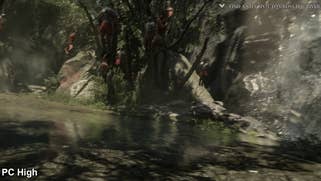
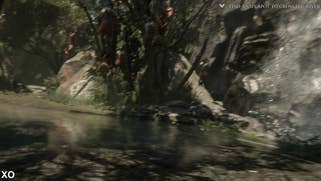
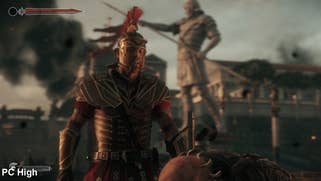



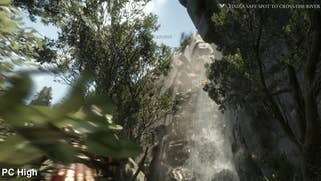
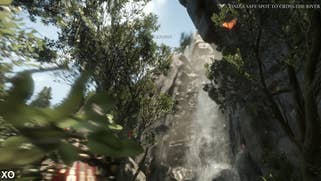


We hope to look at this more closely when we have final code, but first impressions suggest that the PC version of Ryse is all about making the most of the existing work Crytek created for the Xbox One game - any nips and tucks are ironed out, resolution and performance is customisable, but fundamentally we suspect that the same raw materials are at play.
This may cause concern for some because to get the most out of Ryse, you're going to need exceptional hardware. The R9 290 carried off the spectacular opening of the campaign with no problem, but the forest stage appears to be an altogether more taxing beast - in this case, even the mighty GTX 980 could not sustain 1080p60 at the highest presets. Crytek says that the press build is not representative of the final build performance-wise, and pretty much the only exercise it prohibited on the build it released was benchmarking.
However, the feeling we get is that a maxed-out Ryse is going to challenge a lot of lower-end hardware - and that 30fps cap may well turn out to be rather more useful than you may think. If the GTX 980 in combination with a 4.3GHz Core i7 isn't consistently blitzing this game at 1080p60, the talk of 4K support and the inclusion of super-sampling anti-aliasing seems like more of a 'future-proofing' option as opposed to something enthusiast gamers can access in the here and now.
Of course, we are talking about max settings here. Our press demo had three quality settings on offer - low, normal and high. We took a bunch of comparison shots of each preset, then matched them up with the Xbox One version of the game. In an ideal world, we would have configured the PC game to match the 1600x900 upscale offered by the Microsoft console, but that specific framebuffer size didn't appear to be present as a configuration option. However, the upshot is that for the most part, Xbox One does indeed appear to match the top-end PC experience - with select settings perhaps tweaked on a per-scenario basis. A look at the final version of the game should prove more illuminating.
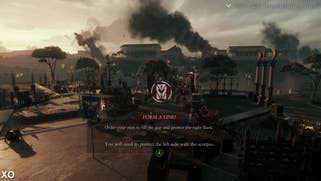

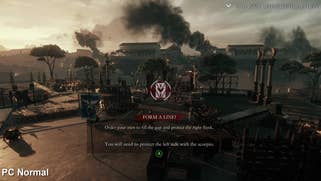
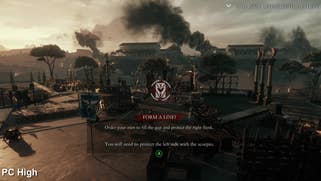
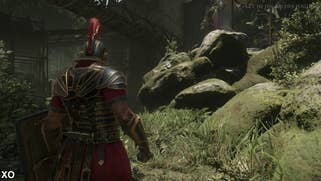
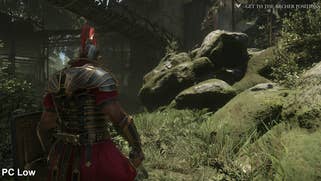



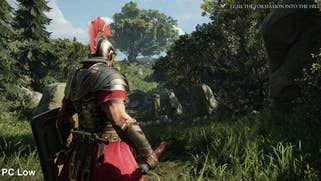
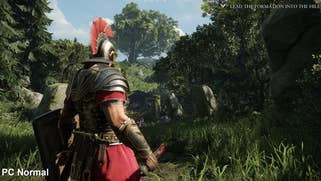
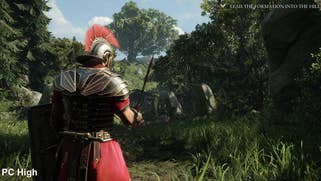









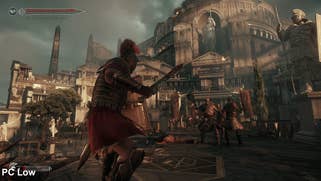


Access to a cut-down version of the game so close to release is admittedly a touch frustrating. We don't know whether some scenes are final or not - and there are some oddities present in the build we tested. For example, the fire effect seen in the palace siege when Marius is in command of a mammoth crossbow is very poorly animated in our build: different elements of the fire each flicker in turn on a 15fps refresh, looking very odd indeed. Surely that would have been fixed in a final QA pass? Regardless, we look forward to finding out.
Here at Digital Foundry, we have conflicting memories of our initial Xbox One playthrough of Ryse. With a deluge of next-gen games to look at, we never did complete the campaign, nor sample the multiplayer. But there was the sense that the gameplay was a real grind, and we only really persisted - as much as time allowed - in order to sample what was clearly an exciting leap forward in rendering technology, combined with stunning art direction and some spectacular set-pieces. Returning to the Xbox One game this week, it's clear that Ryse is rich with breathtaking spectacle, with the third campaign level's beachhead assault standing out in particular. 10 months on, many of its technological achievements have still yet to be matched.
As a visual showcase then, the appeal of Ryse remains undiminished, and for those with capable enough PCs who go into the experience with their eyes open on the rather spartan gameplay, there will be much to enjoy. This should hopefully be the Ryse experience with no compromise, tailored to the wants and needs of the user. It won't be everyone's cup of tea - but we'll level with you: we can't wait to play the final game.
